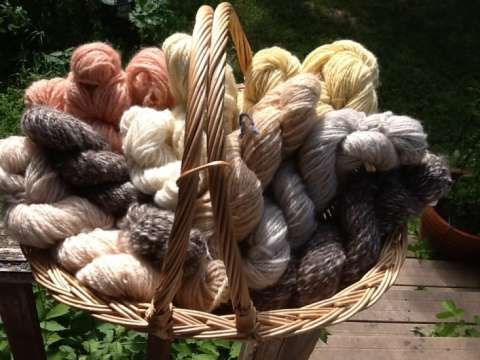July 24, 2013
Red Cabbage Revisited

 I decided that I was unhappy with my first attempt at dying wool with red cabbage (see 6/22/13). I have seen so many examples where people have gotten much stronger colors than I did. I decided to try the whole thing over still using alum and cream of tarter as a mordant. I prepared the dye bath the same as before, only this time I mordanted the yarn, not the pot. I was hoping this would result in stronger colors in the yarn. I have read that you can mordant the pot if you are only going to use one mordant. Later, I read on another article that not all the mordant bonds with the fiber that way and that some may stay in the pot. Any comments either way on this would be appreciated.
I decided that I was unhappy with my first attempt at dying wool with red cabbage (see 6/22/13). I have seen so many examples where people have gotten much stronger colors than I did. I decided to try the whole thing over still using alum and cream of tarter as a mordant. I prepared the dye bath the same as before, only this time I mordanted the yarn, not the pot. I was hoping this would result in stronger colors in the yarn. I have read that you can mordant the pot if you are only going to use one mordant. Later, I read on another article that not all the mordant bonds with the fiber that way and that some may stay in the pot. Any comments either way on this would be appreciated.I dyed one 100g skein of a yarn I had spun using 25% silk and 75% wool. I also dyed 100g of hand spun wool. I used the low heat method to mordant both skeins since I had silk in one. Over heating silk can cause it to lose its luster. With this method, I added the mordant to the water and brought it to a boil, making sure the mordant was completely dissolved. I then turned the heat off, let the pot stand for a couple minutes and then added the yarn. I let these stand over night and rinsed them both well in the morning.
The first pot I ran was the green. I used the yarn with the silk in it for this. I figured I could simmer the second batch for the red if I needed to. I used the low heat method to dye the yarn. Again, I brought the dye pot to a boil and then let it stand for a few minutes. I also added a half tablespoon of baking soda. This turned the pot to green. I added the yarn and took the pot off the stove. I let it steep until it was completely cooled. I m very happy with the results I got!

After removing the yarn from the dye bath I washed it in Eucalan and let it dry. Then I got the pot ready for the second run, the red run. I heated the dye bath back up to simmer. This Imelda I added citric acid to the pot until I got a nice shade of red. There was a lavender in there during the shift, but I couldn't keep it. (next time...).
I simmered this pot for about and hour, then removed the yarn, washed it and let it dry as well.
I a much happier with these results. I am glad I kept at it.
 |


